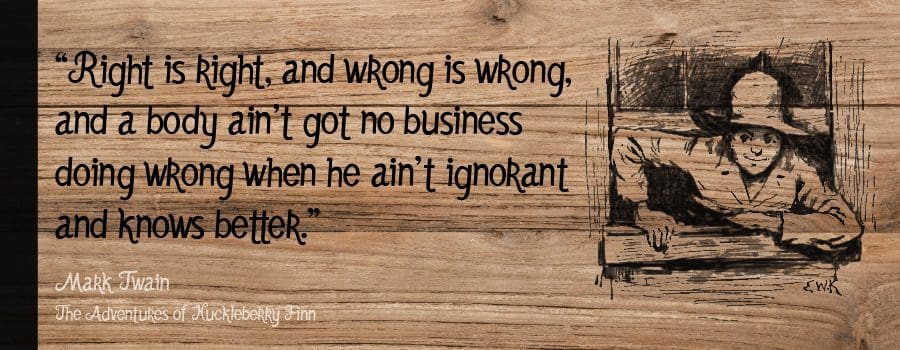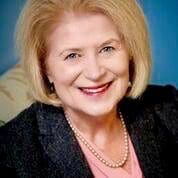Search Posts
Recent Posts
- RI Veterans: Did you know? 25.04.24 (100th for Louis Dolce, events, resources) – John A. Cianci April 25, 2024
- Business Beat: Bad Mouth Bikes takes home 3 national awards April 25, 2024
- Rhode Island Weather for April 25, 2024 – John Donnelly April 25, 2024
- We Cook! Mill’s Tavern’s Cajun North Atlantic Swordfish, Mango Salsa, Cilantro Citrus Aioli April 25, 2024
- The Light Foundation & RI DEM’s 4th Annual Mentored Youth Turkey Hunt a success April 25, 2024
Categories
Subscribe!
Thanks for subscribing! Please check your email for further instructions.

Why Did We Ban The Adventures of Huckleberry Finn?
By Mary T. O’Sullivan, MSOL
One of America’s great authors, Mark Twain, was a prolific satirist and social commentator. As an example of great American literature, The Adventures of Huckleberry Finn remained on the required reading list for most 10th grade students following the New York State Regents Curriculum in the 1980s. Was some of the language shocking? Yes. Did we say the offensive language out loud in class? No. Now this great book is banned from most school curriculums for one simple reason. Since the 1990s, we are willing to ignore the subtleties, and nuances of a complex piece of literature.
In Huck’s time, the 1840s or so, in the United States, much of the offensive references to Jim, the runaway slave were very common. Mark Twain uses these references to point out the general ignorance of those times, and how he personally objected to the enslavement of other human beings. But now we find it too hard to dig deep into his true meaning and purpose. It is so much easier to condemn a book on the basis of superficial arguments.
When reading the story, we learn that Huck himself comes from an abusive and poverty-stricken background. We discover that his alcoholic father has kidnapped him and took away his freedom in order to steal a windfall Huck gained in the earlier story of The Adventures of Tom Sawyer. In this sense, Huck yearns for freedom as much as his friend Jim, the runaway slave does. Both manage to escape but must not be caught.
Some of Huck’s antics are pure Twain humor. Huck disguises himself as a girl, runs away from two women who are trying to “silvize” him. In one instance, when one of his female patrons tells Huck that “she was going to live so as to go to the good place [heaven],” Huck, considering what he knows about the woman and the prissy, squeaky clean lifestyle that makes her content, replies that he “couldn’t see no advantage in going where she was going,” and makes up his mind to not try to get there. This scenario underlines Mark Twain’s commentary on religion and the hypocrisy of people who believe in the Bible, but also in slavery.
The theme of the contrast between living freely and “being civilized” runs throughout the novel. Huck’s desire to throw off the constraints of society and Jim’s struggle for the freedom from bondage mirror each other. And in their adventure down the Mississippi River in the 1840s shows how the obstacles of what was considered “proper society” constantly get in their way. Huck’s honest storytelling, with no frills attached, provides the author, Mark Twain, with the opportunity to make scathing comments about the hypocritical society of the time.
The historical realities of the time, the existence of slavery and racial division, are considered to be the most important and most controversial themes of The Adventures of Huckleberry Finn. The offensive references to Jim in Chapter One are meant to ready the reader for more of the same in later chapters. It’s like a wakeup call that says this book is not going to ignore the ugly realities of our society. Mark Twain chose to use the dialect of the times, to demonstrate how people acted and thought. He knew these pejorative terms; he heard them spoken. He made the point that people were living a so-called Christian lifestyle but will turn in a runaway slave. How is that human behavior? It’s a radical concept that Twain shows us through the eyes of a young, uneducated boy.
However, readers should be aware of two major points that Mark Twain was making. One source states it perfectly: “First, the novel is a satire; that is, irony, sarcasm, or caustic wit are used to attack or expose folly, vice, or stupidity. Second, the novel is first person narrative (told from Huck’s point of view). Confusing either of these issues can lead the unsophisticated reader to drastic misinterpretations. The feelings and interpretations of situations, issues, and events advanced by Huck are not necessarily those the author is advocating.”
The point is, Huck is a young boy, and he has some conflicting ideas about staying with Jim. He’s a little bit afraid, since Jim is a runaway. On a larger scale, Huck reflects some of the ignorance of the day, and blurts out some of the prevailing thoughts, conflicts and feelings about being with Jim. However, this attitude also pointedly illustrates the moral blindness of the society in which the two find themselves.
The portrayal of Jim, sometimes considered unflattering, underscores Mark Twain’s disdain of prejudice of the time, and of the reader as well. Mark Twain lashes out at the sinful practice of slavery and racial discrimination of Huck’s time, but also at the time of the book’s release, years after the book’s setting, in 1885. These portrayals are now considered scandalous, but again, unless people learn to comprehend Mark Twain’s mission of social commentary, we’ll never grasp the true efficacy of the book.
Throughout the book there are instances where Huck learns that often acting on the expectations and demands of society isn’t always the right thing, and when he follows his better instincts, he can make the right decisions. At one point, Huck is approached by men looking for runaway slaves. Here, Huck could have easily turned in his friend, but his inner heart is telling him that he loved Jim as a brother, and he knew that he had to do what was right.
So, why don’t we teach The Adventures of Huckleberry Finn anymore?
It’s apparent that Mark Twain’s observations are still valid. That our society is still hypocritical, that racial discrimination is still alive and well, and bias toward people of color is bursting out today in a major way. Keeping a book like Huck Finn out of the educational system is just as good as ignoring the problems of today. Mark Twain was satirizing the society of the 1840s and in the time of the book’s publication, he used a 10-year-old boy to tell the story of how to build conscience and moral action. The character of Jim expresses the primordial desire of every human for freedom. And the bond between Jim and Huck demonstrate the bond that all humans need for each other, no matter what color or race they are.

Mary T. O’Sullivan
Mary O’Sullivan has over 30 years of experience in the aerospace and defense industry. In each of her roles she acted as a change agent, moving teams and individuals from status quo to higher levels of performance, through offering solutions focused on changing behaviors and fostering growth.
Mary has a Master of Science in Organizational Leadership from Quinnipiac University. In addition, she is also an International Coaching Federation Professional Certified Coach, a Society of Human Resource Management Senior Certified Professional and has a Graduate Certificate in Executive and Professional Coaching, from the University of Texas at Dallas.
In her leadership and executive coaching, she focuses on improving the executive behaviors that slow down performance and lead to growth, such as soft skills, communication, micro-bias awareness, etc. She has successfully helped other professionals, such as attorneys, surgeons, pharmacists, and university professors, make career decisions to lead to success in their chosen careers. In addition, small business owners have sought Mary’s services to bring their companies into greater alignment, working on their culture, vision, mission, values and goals as well as organizational structure. Mary’s executive coaching has been mainly with large organizations among them: Toray Plastics America, Hasbro, Raytheon Company, Lockheed Martin, CVS Healthcare, Sensata Technologies, Citizen’s Bank, Ameriprise, BD Medical Devices, Naval Undersea Warfare Center, (Newport, R.I.), General Dynamics, University of Rhode Island, Community College of Rhode Island, etc.
Mary has facilitated numerous workshops on various topics in leadership such as, emotional intelligence, appreciative inquiry, effective communication, leading in adversity, etc. She has also written extensively on similar topics.
Mary is also a certified Six Sigma Specialist, Contract Specialist, IPT Leader and holds a Certificate in Essentials of Human Resource Management from the Society of Human Resources Development. Mary is also an ICF certified Appreciative Inquiry Practitioner, and a Certified Emotional Intelligence assessor and practitioner.
In addition, Mary holds a permanent teaching certificate in the State of New York for secondary education with Advanced Studies in Education from Montclair University, State University of New York at Oswego and Syracuse University. She is also a member Beta Gamma Sigma and the International Honor Society.
Mary dedicates herself to coaching good leaders to get even better through positive approaches to behavior change for performance improvement.
